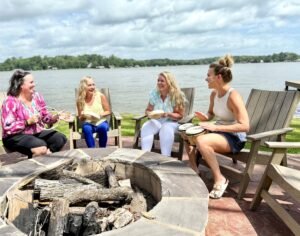Attending a healing retreat—especially one centered around somatic therapy, creative expression, and nervous system regulation—can be a life-changing experience. The insights are powerful, the nervous system finally feels a sense of safety, and for many, it’s the first time they’ve felt truly connected to themselves in years. But what happens after the retreat? What does post-retreat integration look like?
This is where the real work begins. Post-retreat integration is the process of taking everything you experienced—emotionally, physically, spiritually—and weaving it into your daily life. Without intentional integration, it’s easy to slip back into old patterns, leaving those breakthroughs behind.
Why Is Post-Retreat Integration So Important?
Retreats create a unique ecosystem of safety, support, and presence. You’re often unplugged from daily stressors, immersed in a community of like-minded individuals, and guided through deep practices that regulate your nervous system and reconnect you with your body and voice.
But real life is not a retreat.
When you return to your daily routines—work, family, responsibilities—it’s normal to feel a dip in energy or even confusion. That’s why integration practices are essential. They help bridge the gap between the sacred space of the retreat and the often-chaotic pace of everyday life.
1. Create a Daily Grounding Practice
Start simple. Even five minutes a day can help anchor you in the work you did during the retreat.
Some grounding practices we love:
- Somatic check-ins: “What’s happening in my body right now?”
- Gentle movement or stretching
- Creative journaling
- Using scent (aromatics) to cue calm and regulation
- Placing a hand on your heart or belly and simply breathing
This isn’t about doing everything you did at the retreat—it’s about finding one or two practices that bring you back into your body.
2. Honor the Emotions That Arise
You may feel emotional in the days or weeks after a retreat. That’s a sign your system is integrating. Instead of trying to “stay high” or “keep the vibe going,” give yourself permission to feel whatever is present.
Ways to support emotional processing:
- Make art or write poetry to express what you can’t put into words
- Use your retreat journal as a continuation space
- Talk with someone who understands the depth of what you experienced
3. Stay Connected to the Community
If your retreat offered a group experience like ours at Embodied Experiences, lean into the support that was built. Whether it’s a WhatsApp thread, a private Facebook group, or just a few new soul friends, stay in touch.
Community is a powerful integration tool. It helps us remember we’re not alone in this process.
4. Bring Retreat Elements into Your Physical Space
Try incorporating sensory cues from the retreat into your home:
- Use essential oils or diffusers that were used during group work
- Place artwork, photos, or items from the retreat where you’ll see them daily
- Play music that was part of your experience (we always curate a playlist of everyone’s favorite music for this very reason).
These small rituals help your nervous system remember the safety and sacredness of the retreat container.
5. Give Yourself Permission to Go Slow
Integration isn’t a checklist. It’s a slow, unfolding process. You might have moments of clarity followed by days of confusion—and that’s okay.
Your nervous system is re-patterning. Your inner voice is getting louder. Your creative energy is finding new ways to express itself. Let it happen in its own time.
6. Work with a Somatic or Expressive Arts Therapist
If something was activated during the retreat that feels too big to hold alone, seek out a trauma-informed, body-based therapist or coach. Continuing the work with someone trained in somatic experiencing, expressive arts, or nervous system regulation can be deeply supportive.
Many retreat participants benefit from a few follow-up sessions to help solidify the transformation and move through anything still surfacing.
7. Keep Listening to Your Body and Voice
The work we do at Embodied Experiencesis about helping you come home to your body and your unique expression. That journey doesn’t end when you leave the retreat—it begins.
So keep listening:
- What does your body need today?
- What wants to be expressed creatively?
- What feels nourishing right now?
The more you tune in, the more your integration becomes a living practice.
Final Thoughts: Integration Is the Retreat After the Retreat
You don’t need to “maintain the magic.” You are the magic. And with the right practices, support, and self-compassion, you can continue growing long after the retreat ends.
If you’ve attended one of our Embodied Experiences Retreats, know that you’re not alone. We’re here, walking the same path, always rooting for you.
